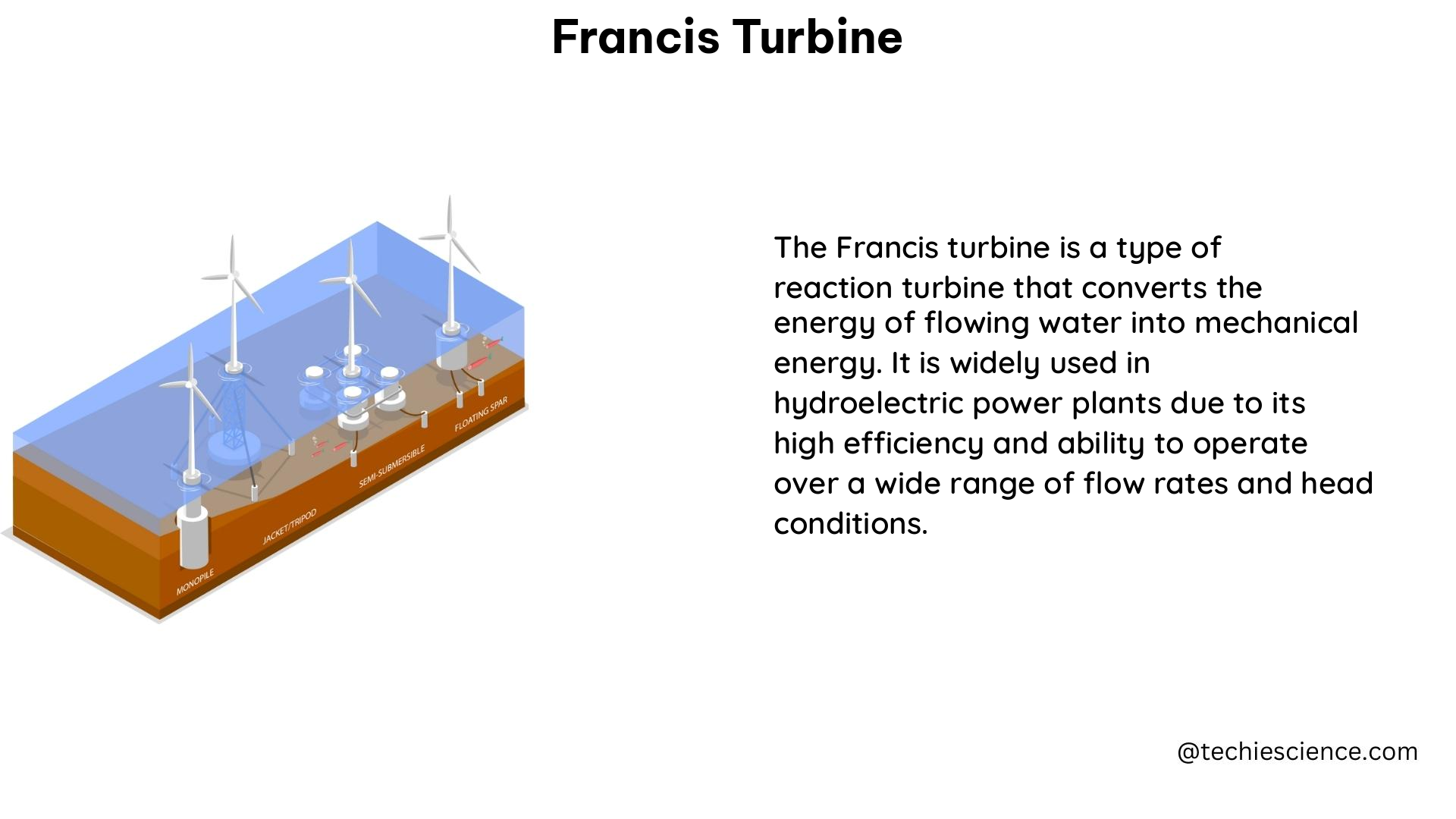The Francis turbine is a widely used type of hydraulic turbine in hydroelectric power plants, renowned for its high efficiency and ability to operate across a broad range of flow rates and head pressures. This comprehensive guide delves into the technical specifications, design principles, performance evaluation, and DIY project considerations for the Francis turbine.
Technical Specifications of the Francis Turbine
The key technical specification of a Francis turbine is its specific speed (n_s), which is a dimensionless parameter that characterizes the turbine’s performance. The specific speed is calculated using the following equation:
n_s = n * (P/H^(1.5))^(0.5)
Where:
– n is the rotational speed of the turbine in revolutions per minute (rpm)
– P is the power output in kilowatts (kW)
– H is the head pressure in meters (m)
The specific speed of a Francis turbine typically ranges from 40 to 300, with higher values indicating a more efficient turbine design. This wide range of specific speeds allows Francis turbines to be tailored for a variety of hydropower applications, from low-head to high-head installations.
Turbine Design and Key Components

The design of a Francis turbine involves the use of advanced computational fluid dynamics (CFD) techniques to optimize the flow of water through the turbine. The turbine is composed of several critical components:
- Spiral Casing: The spiral casing directs the flow of water into the guide vanes, ensuring a smooth and uniform flow.
- Guide Vanes: The guide vanes control the flow direction and velocity as the water enters the runner blades, allowing for precise flow regulation.
- Runner Blades: The runner blades are the heart of the Francis turbine, converting the kinetic energy of the water into mechanical energy that is then transmitted to the generator.
- Draft Tube: The draft tube helps to reduce the loss of kinetic energy as the water exits the turbine, improving overall efficiency.
The design of these components is crucial in maximizing the turbine’s performance and efficiency. CFD simulations are used to model the complex fluid dynamics within the turbine, allowing engineers to optimize the shape and positioning of the various components.
Performance Evaluation Techniques
The performance of a Francis turbine can be evaluated using a variety of measurement techniques, including:
- Particle Image Velocimetry (PIV): PIV systems allow for the measurement of the velocity and pressure distribution within the turbine, providing valuable insights into the flow patterns and identifying areas for potential optimization.
- 2D PIV: Two-dimensional PIV systems focus on specific cross-sections of the turbine, enabling a more detailed analysis of the flow characteristics.
These advanced measurement techniques provide a wealth of data that can be used to fine-tune the turbine’s design and operation, ultimately improving its overall efficiency and performance.
DIY Francis Turbine Projects
For those interested in hands-on exploration, it is possible to build a small-scale model of a Francis turbine for educational or research purposes. This can be done using a variety of materials, such as PVC pipes and fittings, and can be used to study the flow of water through the turbine and the effect of different design parameters on its performance.
When constructing a DIY Francis turbine, it is important to consider the following factors:
- Turbine Scale: The size of the turbine will determine the flow rates, head pressures, and power output that can be achieved.
- Material Selection: The choice of materials, such as PVC, acrylic, or metal, will impact the turbine’s durability, manufacturing complexity, and overall performance.
- Component Design: Careful design of the spiral casing, guide vanes, runner blades, and draft tube is crucial to ensure efficient water flow and energy conversion.
- Measurement Techniques: Incorporating measurement tools, such as flow meters, pressure sensors, and tachometers, can provide valuable data for analyzing the turbine’s performance.
By building a small-scale Francis turbine, enthusiasts can gain a deeper understanding of the principles of hydraulic turbine design and operation, while also exploring opportunities for further research and optimization.
Conclusion
The Francis turbine is a highly efficient and versatile type of hydraulic turbine that plays a crucial role in hydroelectric power generation. Its technical specifications, including the specific speed, and its advanced design involving CFD techniques, ensure optimal performance across a wide range of operating conditions.
The performance of a Francis turbine can be thoroughly evaluated using measurement techniques such as PIV and 2D PIV, providing valuable insights for design improvements. Furthermore, the possibility of constructing DIY Francis turbine models offers an exciting opportunity for hands-on exploration and experimentation, fostering a deeper understanding of this remarkable technology.
References
- Assessing hydraulic conditions through Francis turbines using an Sensor Fish at three different dams: Arrowrock Dam, Cougar Dam, and Detroit Dam. https://www.sciencedirect.com/science/article/pii/S0960148116307303
- Flow measurements around guide vanes of Francis turbine: A PIV approach. https://www.sciencedirect.com/science/article/abs/pii/S0960148118303537
- Measurements on a Model Francis Turbine during Start-Stop. https://www.researchgate.net/publication/336439352_Measurements_on_a_Model_Francis_Turbine_during_Start-Stop
- Flow Field in a High Head Francis Turbine Draft Tube During Part-Load Operation. http://www.diva-portal.org/smash/get/diva2:1153137/FULLTEXT02.pdf
- TO SCIENTIFIC ENGINEERING: – James B. Francis. https://math.dartmouth.edu/~mqed/NLA/SciEngin/SciEngin_rt5.pdf

The lambdageeks.com Core SME Team is a group of experienced subject matter experts from diverse scientific and technical fields including Physics, Chemistry, Technology,Electronics & Electrical Engineering, Automotive, Mechanical Engineering. Our team collaborates to create high-quality, well-researched articles on a wide range of science and technology topics for the lambdageeks.com website.
All Our Senior SME are having more than 7 Years of experience in the respective fields . They are either Working Industry Professionals or assocaited With different Universities. Refer Our Authors Page to get to know About our Core SMEs.